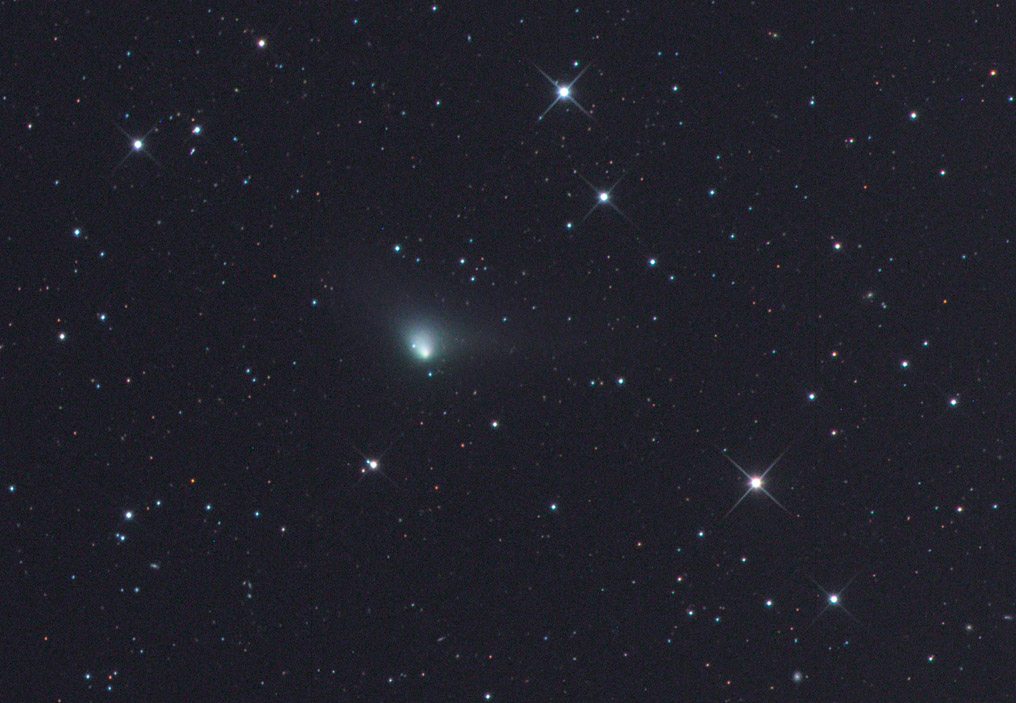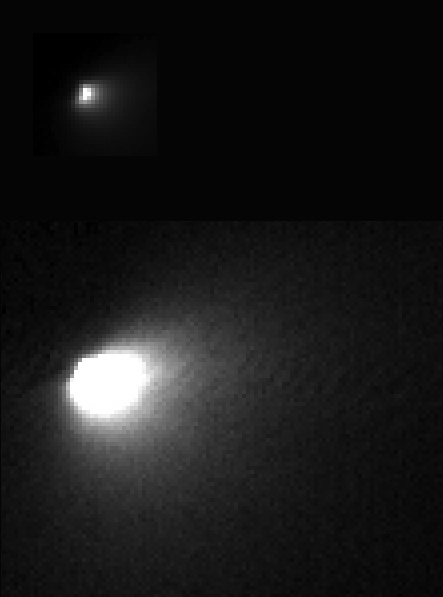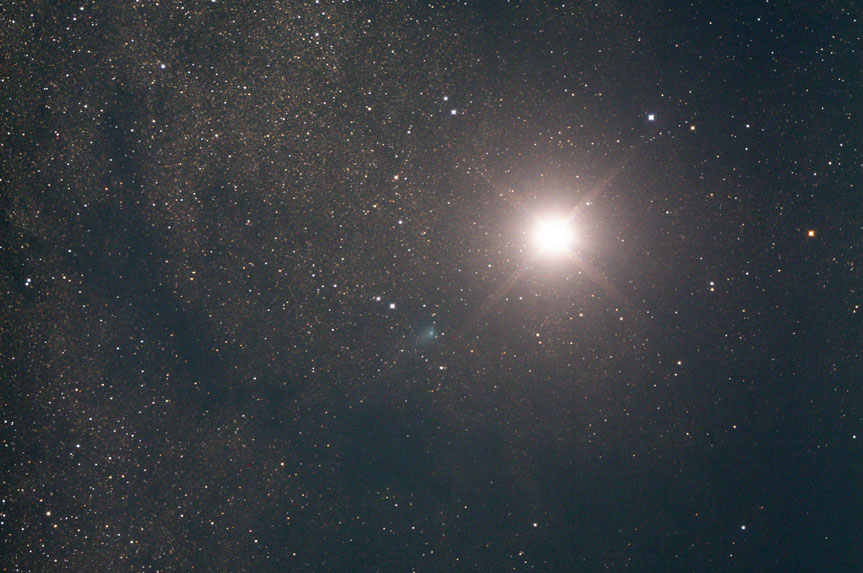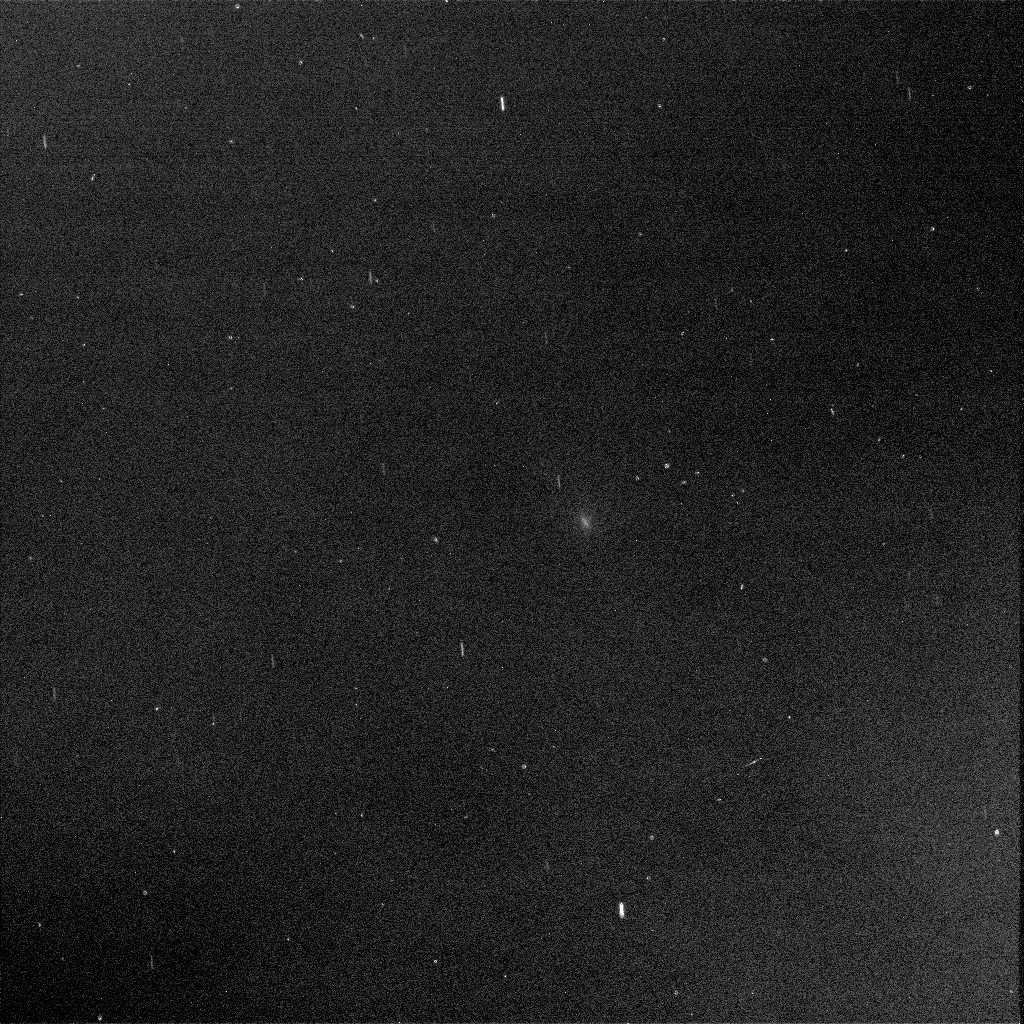
Perihelion: 2014 October 25.30, q = 1.399 AU
Of the various comprehensive survey programs that have been operational since the first such programs commenced in the late 1990s, only one has been based in the southern hemisphere: the Siding Spring Survey, based at its namesake observatory in New South Wales and which operated with funding from NASA under the management of the Catalina Sky Survey program based in Arizona. The Siding Spring Survey became operational in 2004 and ran until its funding was terminated in mid-2013, and during that time managed to gather a respectable collection of discoveries of comets and near-Earth asteroids, perhaps the most memorable discovery being Comet McNaught C/2006 P1, which became a “Great Comet” in early 2007 and which is a previous “Comet of the Week.”
One of the most important Siding Spring discoveries came just a few months before the program shut down when on January 3, 2013, Rob McNaught discovered a dim object of about magnitude 18.5. Poor atmospheric conditions and a collimation problem with the telescope prevented its cometary nature from being determined right away – hence the name “Siding Spring” – but observations soon showed that McNaught’s object was a condensed comet over 21½ months away from perihelion passage and located at a heliocentric distance of 7.20 AU.

Orbital calculations soon began to show that in October 2014 – just a few days before perihelion passage – Comet Siding Spring would be passing extremely close to Mars. Indeed – and in the process described within a previous “Special Topics” presentation – Mars remained within the comet’s “error ellipsoid” for a while, but calculations eventually established that at the time of closest approach on October 19 the comet’s “miss distance” would be a very small 0.00094 AU – 141,000 km, just barely over 1/3 of the Earth-moon separation. I will confess that at least among some of us involved in cometary astronomy (as well as within the planetary defense community) there was some disappointment that there wouldn’t be an actual impact; in addition to being a truly spectacular event in and of itself, the scientific windfall from an impact (which, since the comet’s orbit is retrograde, would have occurred at a relative velocity of 56 km/sec) would have been enormous. Still, with an international armada of spacecraft both in orbit around Mars and upon Mars’ surface, this provided an unprecedented opportunity to obtain close-up observations of a long-period comet from the Oort Cloud.
The comet brightened slowly over the months following its discovery, and by the end of 2013 had become visually detectable at 14th magnitude. After conjunction with the sun in early May 2014, it emerged into the southern hemisphere’s morning sky at around 13th magnitude and brightened steadily from that point, finally reaching 10th magnitude around the time it was closest to Earth (0.89 AU) in early September, at which time it was in southern circumpolar skies. From that point, it began traveling northward but also began fading, and was near 11th magnitude at the time of its passage by Mars.

Among the active spacecraft orbiting Mars at the time of the encounter were NASA’s Mars Odyssey, Mars Reconnaissance Orbiter (MRO), and –just recently arrived – Mars Atmosphere and Volatile EvolutioN (MAVEN) missions, ESA’s Mars Express, and – also just recently arrived – ISRO’s Mars Orbiter Mission. On the surface, NASA’s Opportunity and Curiosity rovers were also operational. To prevent damage from sandblasting and stray electrical charges resulting from impacts from dust grains, all the orbiting spacecraft were placed on the opposite side of Mars at the time of the impact. Even so, the various missions were able to conduct some unique scientific observations: MRO was able to determine that the nucleus was an unexpectedly small 700 meters in diameter, and MAVEN detected large numbers of metal ions entering Mars’ atmosphere, suggesting that someone on the surface might have witnessed an intense meteor shower (although the strength of this might have been diminished due to the thinness of Mars’ atmosphere).
Both the Curiosity and Opportunity rovers were able to image Comet Siding Spring in the Martian sky. (Based upon the comet’s brightness as seen from Earth, it would have appeared near magnitude -4 or -5, albeit spread out over several tens of degrees of sky.) The lighting conditions at Curiosity’s site were poor and the resulting images don’t show much, but the comet does show up reasonably well in the images taken by Opportunity. This was the first time that images of a comet were taken from the surface of another planet.

As seen from Earth, Comet Siding Spring and Mars were two arcminutes apart at the time of closest approach. Afterward, the comet gradually sank lower in the evening sky, although shortly before mid-November it underwent a small outburst which briefly brought it up to near magnitude 9.5. After conjunction with the sun in mid-December, it reappeared in the morning sky in mid-January 2015 near magnitude 11.5; I was able to follow it visually until near the end of March, and the final astrometric observations were obtained in late January 2017, by which time its heliocentric distance was 8.50 AU and it had faded to 20th magnitude.
While Comet Siding Spring was the first, perhaps there may eventually be other comets observed from the surface of Mars. Perhaps by humans? Perhaps by “Ice and Stone 2020” participants? I leave the answers to these questions to those who are reading this . . .
More from Week 43:
This Week in History Special Topic Bonus Content Free PDF Download Glossary
Ice and Stone 2020 Home Page


